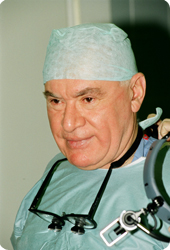Chief Editor
Leo A. Bockeria, MD, PhD, DSc, Professor, Academician of Russian Academy of Sciences, President of Bakoulev National Medical Research Center for Cardiovascular Surgery
Sort by
Dislocation of pacemaker electrodes as a result of a road traffic accident
Authors:
Company:
Bakoulev National Medical Research Center for Cardiovascular Surgery, Moscow, Russian Federation
E-mail: Сведения доступны для зарегистрированных пользователей.
DOI:
UDC: 616.12-089.843-77:615.841-089
Link: Clinical Physiology of Blood Circulaiton. 2025; 22 (2): 193-198
Quote as: Buziashvili Yu.I., Asymbekova E.U., Tugeeva E.F., Sopov O.V., Rychina I.E., Borbodoeva B.M., Akildzhonov F.R. Dislocation of pacemaker electrodes as a result of a road traffic accident. Clinical Physiology of Circulation. 2025; 22(2): 193–198 (in Russ.). DOI: 10.24022/1814-6910-2025-22-2-193-198
Received / Accepted: 10.06.2025 / 25.06.2025
Full text:Abstract
Lead dislocation is defined as any change in the initial position of the lead after implantation, regardless of the presence of clinical or electrophysiological consequences. However, only those cases that lead to dysfunction of the pacing system are considered clinically significant. Early dislocations are observed much more often than late ones, and they predominantly affect the atrial leads. In biventricular pacing, the frequency of dislocations is higher, which is due, in particular, to the instability of the lead position in the coronary sinus. Early dislocations are the most common reason for lead reimplantation, while late dislocations, occurring after a six-week period, are much less common. In our clinical case, we describe a rare variant of pacemaker lead dislocation against the background of a road traffic accident with subsequent successful reimplantation.References
- Carrington M., António P.S., Rodrigues N., Nunes-Ferreira A., Bernardes A., Pinto F.J. et al. New technique for preserving cephalic vein flow in pacemaker implantation ipsilateral to arteriovenous fistula. nova técnica de preservação do fluxo na veia cefálica durante implantação de marca-passo ipsilateral a fístula arteriovenosa. Arq. Bras. Cardiol. 2023; 120 (5): e20220926. DOI: 10.36660/abc.20220926
- Glikson M., Nielsen J.C., Kronborg M.B., Michowitz Y., Auricchio A., Barbash I.M. et al. 2021 ESC Guideli-nes on cardiac pacing and cardiac resynchronization therapy. Eur. Heart J. 2021; 42 (35): 3427–3520. DOI: 10.1093/eurheartj/ehab364
- Arya A., Di Biase L., Bazán V., Berruezo A., d'Avila A., Della Bella P. et al. Epicardial ventricular arrhythmia ablation: a clinical consensus statement of the European Heart Rhythm Association of the European Society of Cardiology and the Heart Rhythm Society, the Asian Pacific Heart Rhythm Society, the Latin American Heart Rhythm Society, and the Canadian Heart Rhythm Society. Europace. 2025; 27 (4): euaf055. DOI: 10.1093/europace/euaf055
- Schvartz N., Haidary A., Wakili R., Hecker F., Kupusovic J., Zsigmond E.J. et al. Risk of cardiac implantable electronic device infection after early versus delayed lead repositioning. J. Cardiovasc. Dev. Dis. 2024; 11 (4): 117. DOI: 10.3390/jcdd11040117
- Голухова Е.З., Ревишвили А.Ш., Базаев В.А., Филатов А.Г., Макаренко В.Н., Малиованова И.М. и др. Дислокация желудочкового электрода электрокардиостимулятора в правую легочную вену. Вестник аритмологии. 2012; 67: 66–41. URL: https://cyberleninka.ru/article/n/dislokatsiya-zheludochkovogo-elektroda-elektrokardiostimulyatora-v-pravuyu-legochnuyu-venu
- Голухова Е.З. Отчет о лечебной и научной работе Национального медицинского исследовательского центра сердечно-сосудистой хирургии им. А.Н. Бакулева Минздрава России за 2024 год. Перспективы дальнейшего развития. Сердечно-сосудистые заболевания. Бюллетень НЦССХ им. А.Н. Бакулева РАМН. 2025; 26 (спецвыпуск): 5–130. DOI: 10.24022/1810-0694-2025-26S
- Голухова Е.З. Отчет о научной и лечебной работе Национального медицинского исследовательского центра сердечно-сосудистой хирургии им. А.Н. Бакулева Минздрава России за 2023 год и перспективы развития. Сердечно-сосудистые заболевания. Бюллетень НЦССХ им. А.Н. Бакулева РАМН. 2024; 25 (Спецвыпуск): 5–141. DOI: 10.24022/1810-0694-2024-25S
- Carrington M., António P.S., Rodrigues N., Nunes-Ferreira A., Bernardes A., Pinto F.J. et al. New technique for preserving cephalic vein flow in pacemaker implantation ipsilateral to arteriovenous fistula. nova técnica de preservação do fluxo na veia cefálica durante implantação de marca-passo ipsilateral a fístula arteriovenosa. Arq. Bras. Cardiol. 2023; 120 (5): e20220926. DOI: 10.36660/abc.20220926
- Glikson M., Nielsen J.C., Kronborg M.B., Michowitz Y., Auricchio A., Barbash I.M. et al. 2021 ESC Guideli-nes on cardiac pacing and cardiac resynchronization therapy. Eur. Heart J. 2021; 42 (35): 3427–3520. DOI: 10.1093/eurheartj/ehab364
- Arya A., Di Biase L., Bazán V., Berruezo A., d'Avila A., Della Bella P. et al. Epicardial ventricular arrhythmia ablation: a clinical consensus statement of the European Heart Rhythm Association of the European Society of Cardiology and the Heart Rhythm Society, the Asian Pacific Heart Rhythm Society, the Latin American Heart Rhythm Society, and the Canadian Heart Rhythm Society. Europace. 2025; 27 (4): euaf055. DOI: 10.1093/europace/euaf055
- Schvartz N., Haidary A., Wakili R., Hecker F., Kupusovic J., Zsigmond E.J. et al. Risk of cardiac implantable electronic device infection after early versus delayed lead repositioning. J. Cardiovasc. Dev. Dis. 2024; 11 (4): 117. DOI: 10.3390/jcdd11040117
- Golukhova E.Z., Revishvili A.Sh., Bazaev V.A., Filatov A.G., Makarenko V.N., Maliovanova I.M. et al. Dislocation of the ventricular electrode of the pacemaker into the right pulmonary vein. Bulletin of Arrhythmology. 2012; 67: 66–71 (in Russ.). URL: https://cyberleninka.ru/article/n/dislokatsiya-zheludochkovogo-elektroda-elektrokardiostimulyatora-v-pravuyu-legochnuyu-venu
- Golukhova E.Z. Report on the clinical and scientific activity of Bakoulev National Medical Research Center for Cardiovascular Surgery for 2024. Development prospects. The Bulletin of Bakoulev Center. Cardiovascular Diseases. 2025; 26 (Special Issue) (in Russ.). DOI: 10.24022/1810-0694-2025-26S
- Golukhova E.Z. Report on the scientific and clinical activity of Bakoulev National Medical Research Center for Cardiovascular Surgery for 2023 and development prospects. The Bulletin of Bakoulev Center. Cardiovascular Diseases. 2024; 25 (Special Issue): 5–141 (in Russ.). DOI: 10.24022/1810-0694-2024-25S
About Authors
- Yuriy I. Buziashvili, Dr. Med. Sci., Professor, Academician of the Russian Academy of Sciences, Head of the Clinical Diagnostic Department; ORCID
- Elmira U. Asymbekova, Dr. Med. Sci., Leading Researcher; ORCID
- Elvina F. Tugeeva, Dr. Med. Sci., Leading Researcher; ORCID
- Oleg V. Sopov, Cand. Med. Sci., Cardiovascular Surgeon; ORCID
- Inna E. Rychina, Cand. Med. Sci., Senior Researcher, Head of the X-ray Department No. 1, Center for Radiation Diagnostics; ORCID
- Baktygul M. Borbodoeva, Cand. Med. Sci., Cardiologist; ORCID
- Firdavsdzhon R. Akildzhonov, Cand. Med. Sci., Junior Researcher; ORCID
If you found mistakes, select text and press Alt+A




